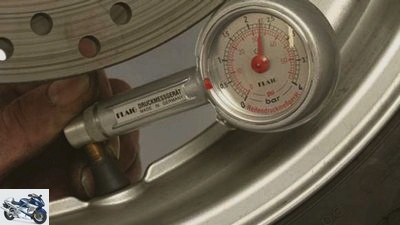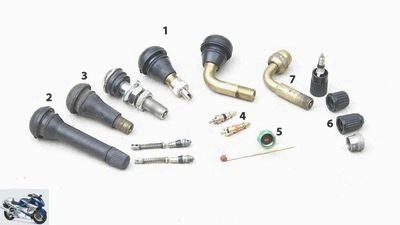Table of contents
- Advice: Find the right air pressure The right air pressure on a motorcycle
- Important tips on the subject “Air pressure”
- More about technology

Schermer
counselor
workshop
Advice: Find the right air pressure
Advice: Find the right air pressure
The right air pressure on a motorcycle
The topic of »air pressure« was briefly dealt with in MOTORRAD 6/2008 ?? and there were so many e-mails on this “airy” topic that we will now devote a little longer to this matter. Especially since on the first trips after the winter break, the popometer’s feelings for “fat undercarriage” are not yet fully trained and therefore an (apparent) undercarriage problem is looked for everywhere, just not with the wrong tire pressure.
Franz Josef Schermer
03/27/2008
The air in the tires “wearing” the load, which is made up of the weight of the vehicle plus that of the crew and luggage. The tire pressures prescribed by the vehicle or tire manufacturer vary depending on the type of vehicle; for street bikes, they are usually between 2.25 to 2.5 bar at the front and 2.5 to 2.9 bar at the rear. For older machines up to 550 cm³ displacement and for slim enduros, the prescribed air pressure is slightly lower (1.7 to 2.1 bar at the front and 1.8 to 2.3 bar at the rear).
The tire pressure prescribed for the motorcycle is in the owner’s manual, but sometimes this information needs to be checked critically. If, for example, a modern tire is mounted on an older motorcycle, the air pressure prescribed by the tire manufacturer can differ from what the vehicle manufacturer prescribed ten or 15 years ago. So: with every new tire (and in case of doubt anyway) ask the tire manufacturer and follow their air pressure recommendation!
Air pressure control
The tire pressure should be at least every two weeks when the tires are cold (maximum 30 degrees Celsius = “lukewarm”) checked and corrected if necessary. When removing the inflation hose from the tire valve, it is important to ensure that too much air does not escape. If the filling hose valve is pulled off sloppily and too slowly, 0.3 to 0.5 bar of air will quickly escape!
Spit test
If the tire continues to lose air without it being possible to tell where the air is escaping, check the valve first. To do this, put a fingertip of saliva on the valve opening (saliva builds up because of surface tension “lid” up) and watch for a few seconds: if the “lid”, the valve is leaking and must be replaced. Always install new and above all short valve inserts.
Tire pressure tester
When checking the tire air pressure, do not necessarily rely on the information on the scale on the petrol station device, but get a proper tire pressure tester and keep it with you in the tool kit. Do not buy a cheap plastic part in the hardware store or supermarket, but a precision measuring device. We have had the best experience with the pressure measuring device from the German manufacturer Flaig (from around 25 euros), it shows exactly and has a sturdy aluminum housing. It is available in well-stocked motorcycle and accessory stores.

archive
Make sure that a short valve body (1) is built into the rim. The long (2) and half-length (3) are from the end of the 1970s and had the uncomfortable property of kinking at high speeds (loss of air) or even tearing off (all air gone at once, bang!). In general, you should only screw in short valve inserts (4), regardless of whether they are in a long hose valve or in a half-length or short hose-free valve. An undamaged (as good as new) rubber seal must sit in the steel valve caps (5). Plastic caps (6) require a sensitive screwdriver hand, otherwise they will tear. If the tire valve is difficult to reach, an auxiliary valve can be used “90 degree bend” Unscrew (7), but please unscrew it again before driving!
Valve caps
Always use well-closing valve caps with a perfect rubber seal. Steel caps are generally better than plastic caps, because they often tear lengthways if they are screwed on too tightly. Without a cap, dirt can get into the valve. Then there is a great risk that the valve will leak, it will develop “creeping flat foot”. Even if the valve insert opens a little at high speeds due to the strong centrifugal forces and air wants to escape, a well-sealing valve cap prevents the air from escaping; the rubber sealing ring acts as a kind of “Safety seal”.
Important tips on the subject “Air pressure”
- Excessive air pressure worsens driving comfort and reduces tire grip.
- If the air pressure is too low, it makes for poor road holding and is particularly problematic for pillion passengers and luggage, as a tire with too low air pressure can quickly overheat under heavy loads, which can lead to severe tire damage.
- The air pressure should be checked regularly, because an air pressure that is 0.2 bar higher or lower than prescribed will have an impact on driving behavior (and thus driving safety)!
- When checking the air pressure, note the following: In a tire that has run hot, the “absolute tire air pressure” can increase by 0.4 bar at the front and by up to 0.5 bar at the rear. This not only happens on the racetrack, but also on sharp pass descents (especially when the machine is fully packed!).
More about technology
PS knowledge: technology
- Motorcycle technology clearly explained on 97 pages (PDF)
- From starter to spark plug
- Simple teaching of physical principles
- Tips and tricks for practitioners
To the PDF for € 9.99
#image.jpg
Related articles
-
Cook 8th pictures Cook 1/8 Solid screwdrivers with a handy shaft are preferable to tools with bits. Cook 2/8 The standard on-board tools are replaced by…
-
Sdun counselor traffic & business Advice on law: barn find Counselor law Barn find Registration impossible without vehicle documents? Of course it works….
-
Driving behavior with changed air pressure
Yvonne Hertler counselor workshop Driving behavior with changed air pressure The correct tire pressure Driving behavior with changed air pressure How…
-
Driving tips and advice on motorcycling
fact 26th pictures MOTORCYCLE 1/26 On the way on alpine passes? That’s how it works! MOTORCYCLE 2/26 Seductive winding curves with risk. The course of…
-
The right tire choice for a motorcycle
Markus Jahn 26th pictures MOTORCYCLE 1/26 On the way on alpine passes? That’s how it works! MOTORCYCLE 2/26 Seductive winding curves with risk. The…
-
Used advice and long-term tester balance
Artist counselor Used purchase Used advice and long-term tester balance Used advice and long-term tester balance 3000 euro bikes Four editors and their…
-
Honda counselor Used purchase Used advice Honda CBF 500 Used advice Honda CBF 500 More than a driving school bike In the ranking of the most…
-
Second-hand advice on turbo motorcycles
counselor Used purchase Second-hand advice on turbo motorcycles Second-hand advice on turbo motorcycles Company hot air The heated start to…
-
Buying advice for cars for motorcycle transport
archive 23 pictures archive 1/23 Although the motorcycle could also be dragged into this family carriage, it is also more convenient: We are presenting…
-
Laverda 650-750 purchase advice
Schermer 21 pictures Schermer 1/21 The Laverda as a used one. You can find out what to consider when buying in this photo show. Schermer 2/21 Has…